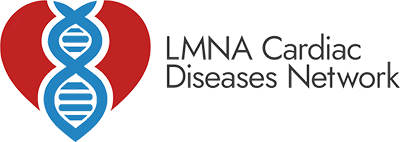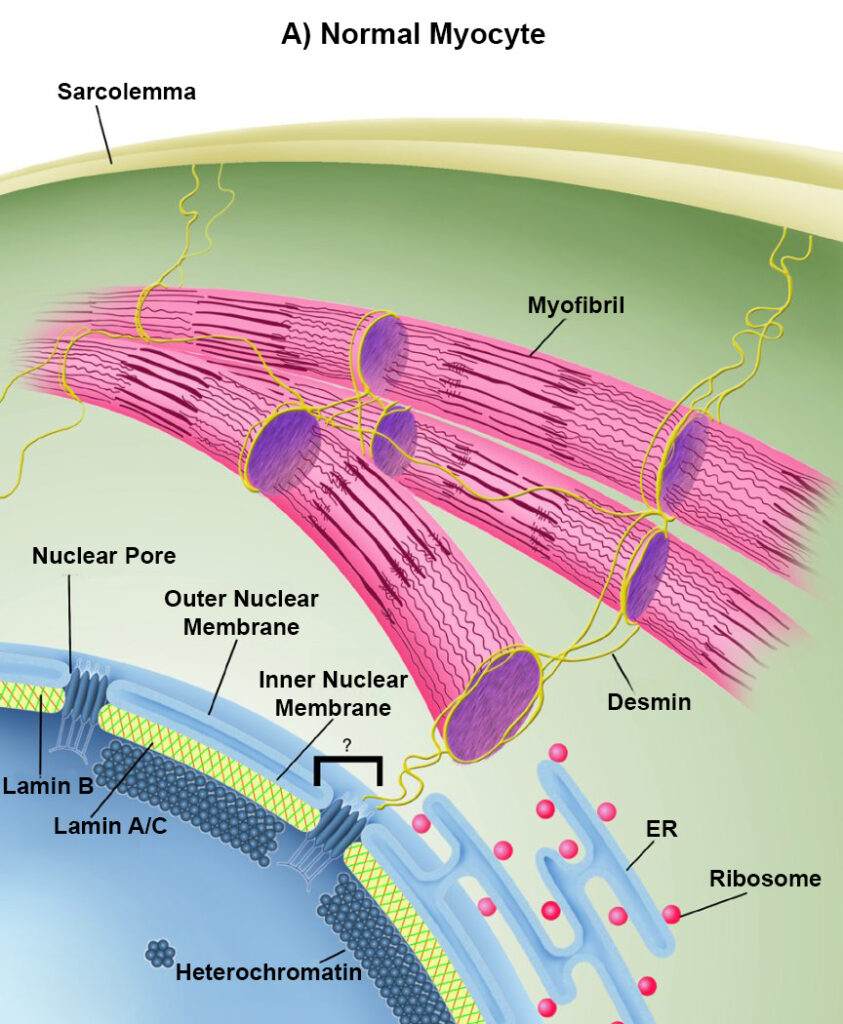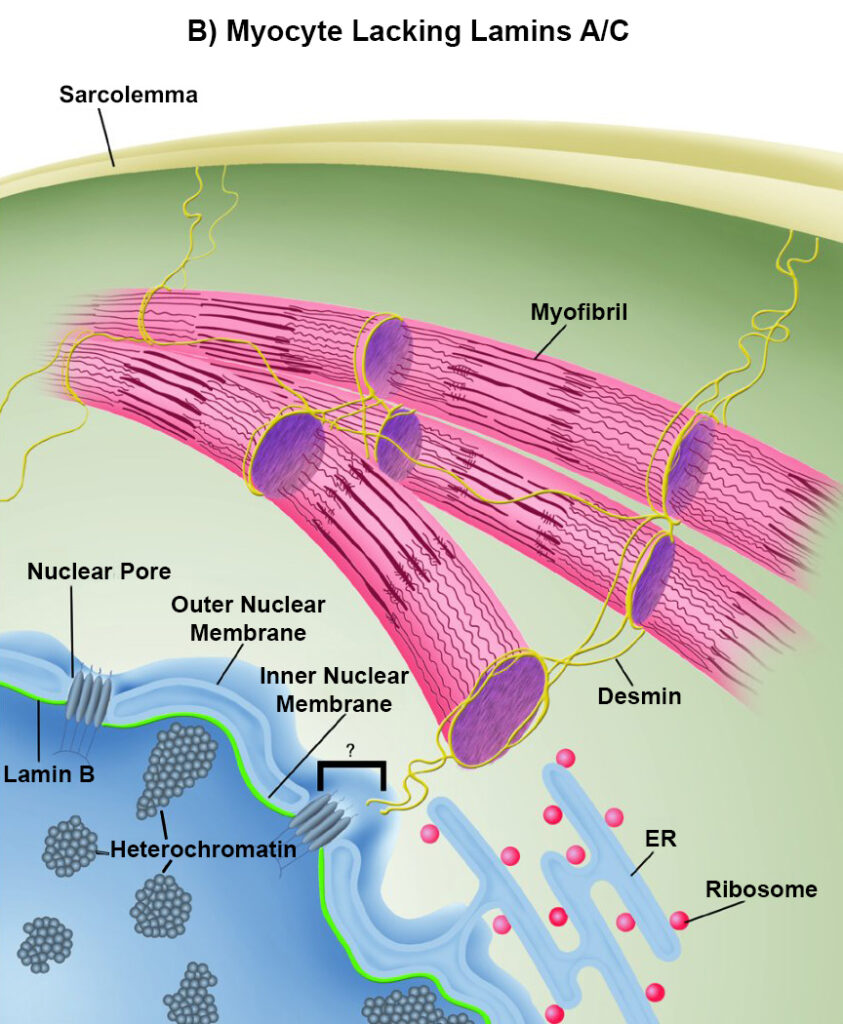Introduction to LMNA
The LMNA gene is like a blueprint for building important parts of our cells. It instructs the body to make proteins called lamin A and C, which are crucial for the structure and stability of a cell's nucleus (the control center of a cell). These proteins act like scaffolding, helping the nucleus keep its shape and support. They also play a role in managing how the cell grows, divides, and repairs itself. In simpler terms, think of the LMNA gene as providing the instructions for creating the 'backbone' of the cell's command center.
The following information from mouse models illustrates these fundamental differences between normal myocytyes and lamin a/c deficient myocytes. For example, the structural abnormalities and disorganization of heterochromatins. Click each image to zoom in.
The following information from mouse models illustrates these fundamental differences between normal myocytyes and lamin a/c deficient myocytes. For example, the structural abnormalities and disorganization of heterochromatins. Click each image to zoom in.
Schematic diagrams showing nuclear envelopes of a normal myocyte (a) and a myocyte from a mouse lacking lamins A and C (b). The nuclear envelope contains the inner nuclear membrane, pore membranes, and the outer nuclear membrane, which is directly continuous with the endoplasmic reticulum (ER). It also contains the nuclear lamina and nuclear pore complexes. The nuclear lamina of a normal myocyte (a) is composed of A-type (lamins A and C) and B-type (lamin B) lamins, which form a meshwork of intermediate filaments (yellow, red, and green). At the periphery of the nucleus, heterochromatin is preferentially associated with the inner nuclear membrane and the lamina. Putative connections (? in figure) may exist between cytoplasmic desmin filaments and the external faces of the nuclear pore complexes. In a myocyte of a lamin A/C–deficient mouse (b), the lamina is composed of only B-type lamins (green), and the nuclear envelopes are irregularly shaped with morphological abnormalities. Nikolova et al. (14) showed that heterochromatin is largely relocated from the nuclear envelope to the interior, which could cause alterations in gene expression. They also showed changes in desmin localization and hypothesized that this may result from alterations of its putative association (? in figure) with the nuclear envelope. Using fibroblasts from lamin A/C–deficient mice, Lammerding et al. (15) showed that nuclear deformities are increased by applied mechanical strain with resultant defective mechanotransduction and attenuated expression of mechanoresponsive genes.
Source: J Clin Invest. 2004;113(3):349-351 https://doi.org/10.1172/JCI20832
Source: J Clin Invest. 2004;113(3):349-351 https://doi.org/10.1172/JCI20832
Overview of LMNA-Related Cardiac Diseases
The expression of LMNA mutations varies greatly among individuals, making each case unique. The same mutation can manifest differently, even among family members, emphasizing the need for personalized medical care. This variability highlights the gene's complex role in health and disease, underlining the importance of a comprehensive approach to diagnosis and treatment. LMNA gene mutations are known for their significant impact on a variety of health conditions, affecting both cardiac and non-cardiac systems. These mutations can lead to diverse diseases, each with its own set of challenges.
- Dilated Cardiomyopathy (DCM): This condition involves the weakening of the heart muscle, leading to an enlarged and less effective heart.
- Arrhythmogenic Right Ventricular Cardiomyopathy (ARVC): A condition where the muscle tissue in the right ventricle of the heart is replaced with fatty and fibrous tissue. This replacement disrupts the heart’s electrical system, leading to arrhythmias.
- Conduction Disorders and Arrhythmias: These heart rhythm problems range from irregular beats to more severe conditions requiring medical intervention.
Importance of Genetic Factors in Heart Diseases
Genetic factors play a significant role in heart diseases, particularly those linked to LMNA mutations. Understanding these genetic underpinnings is crucial for early diagnosis, personalized treatment, and family screening. Advances in genetic research continue to unravel the complex relationship between genes like LMNA and heart health, opening doors for targeted therapies and better management strategies.
Subscribe To Our Newsletter
Show Your Support
Every contribution, regardless of its amount, fuels crucial efforts in research, medical education, patient advocacy, and raising awareness about LMNA cardiac diseases.
You can make a difference in various ways: by committing as a regular monthly donor, offering a single donation, organizing fundraising events both online and in person, contributing to our special tribute funds, or through your unique fundraising initiatives!
DonateDonateYou can make a difference in various ways: by committing as a regular monthly donor, offering a single donation, organizing fundraising events both online and in person, contributing to our special tribute funds, or through your unique fundraising initiatives!


